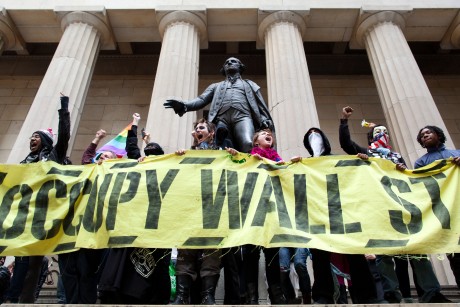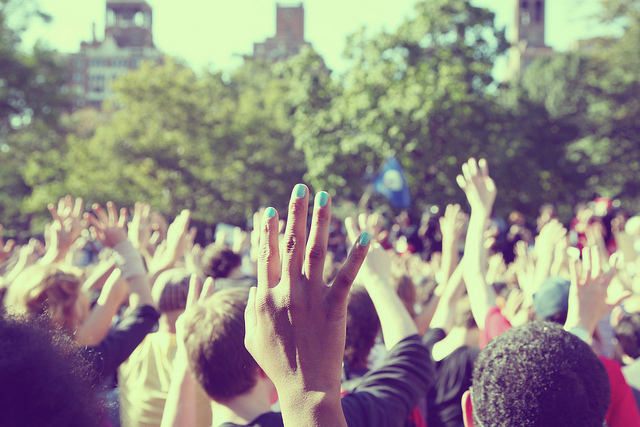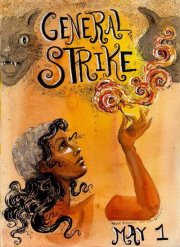by Cinzia Arruzza
April 30, 2012
This article was originally published at Rebel Rabble.
The OWS movement took place after several years of absence of cohesive nationwide movements, and amidst an extreme fragmentation of struggles. The economic crisis and the evident iniquity of the austerity policies implemented by the government created the conditions for a new social explosion. The first great achievement of the OWS movement is that it provided a response to the risk of the rise of a racist and libertarian right. This is always a possible outcome of any economic crisis, and especially now because of the disappointment of the great hopes raised by Obama’s election. OWS also allowed for a reconnection between fragmented struggles to emerge again and give visibility to a plurality of experiences of resistance and protest which, in their isolation of the last decade, were drowned out by the noise of mainstream politics.

Photo: John Minchollo, AP
The 99% discourse has certainly represented one of the major elements of the symbolic and communicative efficacy of the movement: it evoked the force of the numbers, made immediately apparent the deep injustice of neoliberal capitalism, and stimulated a sense of belonging, and of immediate solidarity among the members of the 99%. However, in order to avoid being re-signified in populist terms, the 99% discourse required and still requires articulation. Not only is capitalist society composed by more than just two classes, but even the field of exploited and oppressed people is marked by divisions, disparity of conditions, different experiences and partially divergent short-term interests.
That this basic datum was initially not self-evident within the movement is shown, for example, by the episode recounted by Manissa Maharawal concerning the discussion on the Declaration of the Occupation of Wall Street, in September. The first line of the document stated: “As one people, formerly divided by the color of our skin, gender, sexual orientation, religion, or lack thereof, political party and cultural background, we acknowledge the reality: that there is only one race, the human race . . .” (1) Only after Manissa and her friends stood up and “blocked” the discussion, offering to the people gathered in the assembly an accelerated course on white privilege, structural racism and oppression, was the line finally erased.
The “formerly divided” of the initial draft revealed indeed some difficulties in, or resistance to, understanding that racial, sexual, gender divisions, are not just a matter of false consciousness, or of fake ideological assumptions, which can be immediately or almost magically overcome within the struggle through just an appeal to the unity of the “human race”. On the contrary, they have a very material basis, play a decisive role in the reproduction of capitalist relations, produce sets of sedimented habits and behaviors, and rely on the appeal of short-term interests. This is why what is required for them to be addressed is not alchemy, but rather a political strategy.
Between the pulverization into hundreds of different identities, all characterized by diverse forms of oppression and exploitation, and the longing for unity and homogenization in the name of the “human race”, or of the immediate magic negation of all instances of the capital-relation, it might seem that little or no space is left for an alternative view. However, there is something interesting in the story told by Manissa. In the face of the infamous first line of the Declaration, of the resistance opposed to her “block”, of the initial lack of understanding for her reasons, she did not leave. She stayed and insisted “that in order for this movement to be inclusive it needed to acknowledge these realities and find creative ways to work through them instead of ignoring them” (2). In other words she implicitly raised the question of strategy, of the necessary temporal framework which both separates and joins the current situation and the goal of the abolition of hierarchizing differences, and of the necessary practices to put in place in order to work through these lines of division within the movement. She and her friends won, the Declaration was changed.
I’m recounting this episode not in order to underline the frequent resistance of social movements to adequately recognize the complexity of class, gender and race relations, a difficulty which often compels the birth of forms of non mixed organization in order to cope with these issues and avoid the ruse of only apparent universalisms. On the contrary, what I find particularly interesting in this episode is rather the emergence of a new space created by the OWS movement, a space which could help overcome the divorce of class politics and gender, and of sexual and race politics.
The ambiguous slogan of the 99% against the 1%, although using a new language and new discursive forms, managed to put again the question of class relations at the center of the American political discourse. If this was still only implicit and not perfectly transparent in the first weeks of the movement, particularly in NYC, it became clearer through the call for the general strike in Oakland, on November 2nd. By this I don’t mean that the OWS movement managed to massively mobilize the working class across the country. On the contrary, the mobilization of the working class, in all the various forms in which this can take place, is exactly what is at stake in the next months, if the movement wants to survive, expand, and possibly gain more than simply a shift in political discourse. But the 99% slogan, the catalyzing power of the movement, the re-emergence of a public space in which alliances among fragmented and dispersed struggles can be built, has opened at least the possibility for a new wave of class struggle. This is because it has given back to class struggle its political legitimacy, after decades of political and cultural delegitimization, dismissal, removal and oblivion.

Photo: Darwin Yamamoto
It is precisely this re-emergence of class politics that raises a crucial question for feminist thought today. In her article “Feminism, Capitalism and the Cunning of History,” Nancy Fraser, referring to the last decades of feminist thought and to the increasing divorce of class politics and gender politics, notices that
With the fragmentation of the feminist critique came the selective incorporation and partial recuperation of some of its strands. Split off from one another and from the societal critique that had integrated them, second-wave hopes were conscripted in the service of a project that was deeply at odds with our larger, holistic vision of a just society. In a fine instance of the cunning of history, utopian desires found a second life as feeling currents that legitimated the transition to a new form of capitalist: post-Fordist, transnational, neoliberal (3).
Indeed, the use of feminist discourse to justify the attacks to Iraq and Afghanistan or the racist laws against Muslim people in France; the aggressive rightwing feminism à la Sarah Palin; the commodification of sexual identities, including homosexual, transsexual, intersexual and queer identities with the birth of new kinds of consumers and market sectors: all of this should really invite us to carefully rethink the divorce between gender politics and class politics and the subsequent dismissal in academia of class discourse altogether, as the event which made feminist and then queer discourse available for institutional and capitalist co-optation.
Fraser concludes her article by suggesting that this is a moment in which feminists should think big, i.e. they should reconnect feminist critique to the critique of capitalism, repositioning in this way “feminism squarely on the Left.” The article was published in 2009, just at the beginning of a world-wide financial and economic crisis with few precedents, in the middle of the failure of the neoliberal model, and two years before the sudden, unexpected, refreshing event which goes under the name of the OWS movement. If Fraser is right in her diagnosis of the impasse of feminist thought today, one may hope that the shock provoked by this state of “normal exception” which characterizes the period we are living in, can help us find a way to get out of this impasse. In particular, my suggestion is that the OWS movement could give us a concrete opportunity to accept the invitation by Fraser to “think big,” and to confront our feminist critique to a concrete experience, that of the new forms of subjectivation and political and social struggle of the last months.
This would imply at least two things. The first, on a theoretical level, is a new availability to seriously analyze the relationships between gender oppression, sexual identities and late capitalism. Recent Marxist theory has offered a much more sophisticated, non-reductionist understanding of concrete social formations, and of the interplay between forms of oppression on the one hand, and the process of extortion of surplus-value and the realization of value on the other. In other words, a large part of Marxist literature has deeply problematized the relationship between, to use a formulation by Rosemary Hennessy, “the discourses by which we make the world intelligible and the structures of accumulation and labor” (4) . By doing this it has largely overcome the trite base-superstructure model, offering in this way powerful tools we can use in order to understand the relationships between gender, sexuality, and capitalist accumulation.
The second necessary move is to think the way in which a feminist critique can help give impulse to the movement, contributing to a new understanding of what class and social struggle is and should be, while at the same time being a constitutive part of the movement. To be clearer, I think that the practical experience of the OWS movement challenges the often separatist and isolationist choices of identity politics, and also the tendency of the last decades toward an increasing de-politicization in particular of gender discourse. Firstly, because, as noted earlier, it made apparent the appeal and the evocative power of the unity of struggles, especially in a situation of the vertical crisis of neoliberal policies and the end of the illusions of well-being promised by late capitalism. Secondly, because within its horizontal organizational form, a plurality of forms of activation, action, and subjectivation have been made possible. In spite of some difficulties and some episodes of clear sexism, the OWS movement has been characterized by a fundamental attempt to be as inclusive as possible. This experience has therefore clearly been a good first step in direction of a re-politicization of gender discourse and of a possible strategic alliance among different social struggles with various protagonists and agents.
However, the risk is that in its strive to be inclusive the movement might just operate a simple addition of separate and almost entirely independent activities, actions, and events. In other words, the risk is to give birth to a sort of potpourri: very nice ambiance, but also quite ineffective. One can notice this kind of trend, for example, in the extreme multiplication of working groups and affinity groups within the OWS movement in NYC: the website of the NYC General Assembly lists today 103 groups. Among meditation, wellness, Tea and herbal medicine, Occupy Yoga, and a “warrior group” with 6 members, one can find also WOW (the Women Occupying Wall Street), a LGBTIQA2Z Caucus, a People of Color Working Group, a Strong Women Rules Working Group, and so on.
While this explosion of creativity and vitality is clearly a positive sign, and indicates a legitimate desire to live alternative social relations, the risk is to cultivate the illusion that the simple addition and coexistence in a same political and social space of groups, identities, actions, and struggles will be sufficient. The risk implicit in the logic of the arithmetic addition of the different identities and of their struggles, moreover, is to go in the direction of a crystallization of identities, and therefore in the direction once again of a depoliticization of the question of identity altogether. On the contrary, I suggest that what is urgent today is the strategic reciprocal articulation both of identities and of a plurality of different struggles. This implies, on the one hand, the identification of common goals and actions, while taking into account the diversity of conditions and needs determined by the various and interrelated forms of oppression, and on the other, the identification of inclusive practices and of internal forms of empowerment for disadvantaged groups among the 99%. Since often some answers come from the movement itself, in order be more concrete, I will give an example that might go in this direction.
The Occupy Oakland call for a general strike on May 1 reads:
In 2011, the number of unionized workers in the US stood at 11.8%, or approximately 14.8 million people. What these figures leave out are the growing millions of people in this country who are unemployed and underemployed. The numbers leave out the undocumented, and domestic and manual workers drawn largely from immigrant communities. The numbers leave out workers whose workplace is the home and a whole invisible economy of unwaged reproductive labor. The numbers leave out students who have taken on nearly $1 trillion dollars in debt, and typically work multiple jobs, in order to afford skyrocketing college tuition. The numbers leave out the huge percentage of black Americans that are locked up in prisons or locked out of stable or secure employment because of our racist society (5).
This text of course might raise the problem of an opposition between unionized workers, on the one hand, and the non-unionized workers and unemployed people, on the other. Such an opposition would be detrimental and should be avoided at all costs. At the same time, the Oakland statement raises a crucial question. What is at stake is to rethink what a strike means in a situation in which the class composition and the organization of labor has radically changed, in which the rate of unemployment is raising, in which underemployed people, women, people of color and immigrants represent an increasing large part of the employed working class, and in which the processes of subjectivation of the working class are not the same as we have known in the past.
This demands reimagining different ways in which the production and the circulation of commodities can be blocked, including the possibility of variable forms of participation in the strike, involving also the sphere of reproduction, and rethinking the sites of the democratic empowerment of the different sectors constituting the working class. Beyond the discussion about the feasibility or utility of calling for a general strike on May 1, what I think is really at stake in this practical experience is the possibility of rethinking what class struggle means, reopening a space in which the particular needs, conditions, and processes of the subjectivation of different social sectors and of different identities can articulate each other.
So, we have here a practical challenge as feminist thinkers and feminist activists: if we want to avoid our critique being systematically co-opted by a capitalist discourse, and one form of oppression being simply replaced by another, in what way can we contribute to this strategic and reciprocal articulation of different struggles? For example, what would our participation in a new form of general strike or in a day without the 99% mean? And, ultimately, what kind of subjects of this common struggle do we want to be?
Cinzia Arruzza was a leading member of Sinistra Critica in Italy. Today she is Assistant Professor of Philosophy at the New School for Social Research in New York and is active with Solidarity.
(1) M. Maharawal, “Standing up”, in Occupy! Scenes from Occupy America, ed. by A. Taylor, K. Cessen and editors from n+1, Dissent, Triple Canopy and The New Inquiry, Verso, Londo-New York 2011, pp. 34-40.
(2) M. Maharawal, “Standing up”, cit., p. 39.
(3) N. Fraser, “Feminism, Capitalism and the Cunning of History”, New Left Review, 56 (2009), p. 99. One can find similar arguments in H. Eisenstein, Feminism Seduced. How Global Elites Use Women’s Labor and Ideas to Exploit the World, Paradigm Publishers, London 2009 and in N. Power, One Dimensional Woman, Zero Books, Hampshire 2009.
(4) R. Hennessy, Profit and Pleasure. Sexual Identities in Late Capitalism, Routledge, New York and London, 2000.

